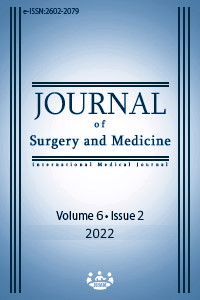Management of aneurysmal subarachnoid hemorrhage with surgical clipping: A single center perspective
Keywords:
Subarachnoid hemorrhage, Surgical clipping, Aneurysm, VasospasmAbstract
Background/Aim: There is no consensus on the optimal treatment for intracranial aneurysm rupture due to subarachnoid hemorrhage (SAH). In this study, we analyzed a series of ruptured intracranial aneurysms treated with the clipping method at our center. Methods: In this retrospective cohort study; we searched our patient database for patients who developed SAH due to ruptured intracranial aneurysm treated at the Neurosurgery Clinic of Sivas Cumhuriyet University. A total of 304 patients who underwent the clipping operation due to aneurysmal SAH between 2010 and 2020 were included in the study. Cases with aneurysmal SAH who underwent endovascular coiling which is consisted of 22 patients were excluded. Results: A significant inverse correlation was found between age and Glasgow coma scores (GCS) (r=−0.137, P=0.017). Hunt–Hess and Fisher grades increased significantly with increasing age (r=0.187, P<0.001 and r=0.185, P<0.001). The mean age of men was significantly lower than that of women (P=0.005). Aneurysms located in the anterior communicating artery were significantly more frequent in men than in women (P<0.001). There was no significant difference in the distribution of other aneurysm locations by gender (P>0.05). No significant differences were observed in GCS scores and Hunt–Hess and Fisher grades between genders (P>0.05). There were no significant effects of aneurysm locations on mortality (P>0.05). Conversely, GCS scores were significantly lower and Hunt–Hess and Fisher grades were significantly higher in the surviving group than in the deceased group (P<0.001). Conclusion: Our study presented the outcomes of patients treated in our clinic with surgical clipping. Based on our findings, we believe that surgical clipping is still a safe and valid treatment method.
Downloads
References
de Rooij NK, Linn FH, van der Plas JA, Algra A, Rinkel GJ. Incidence of subarachnoid haemorrhage: a systematic review with emphasis on region, age, gender and time trends. J Neurol Neurosurg Psychiatry. 2007;78:1365-72.
van Gijn J, Kerr RS, Rinkel GJ. Subarachnoid haemorrhage. Lancet 2007;369:306-18.
Sandvei MS, Mathiesen EB, Vatten LJ, Müller TB, Lindekleiv H, Ingebrigtsen T, et al. Incidence and mortality of aneurysmal subarachnoid hemorrhage in two Norwegian cohorts, 1984-2007. Neurology. 2011;77:1833-9.
D’souza, S. Aneurysmal subarachnoid hemorrhage. Journal of neurosurgical anesthesiology. 2015;27.3:222.
Molyneux A. International Subarachnoid Aneurysm Trial (ISAT) Collaborative Group: International Subarachnoid Aneurysm Trial (ISAT) of neurosurgical clipping versus endovascular coiling in 2143 with ruptured intracranial aneurysms: a randomized trial. Lancet. 2002;360:1267-74.
Wang H-Y, Song J, Gao F, Duan XD, Gao X, Wang Y, et al. Outcomes of microsurgical clipping vs coil embolization for ruptured aneurysmal subarachnoid hemorrhage: a multicenter real-world analysis of 583 patients in China. Medicine. 2019;98.33.
Colby GP, Coon AL, Tamargo RJ. Surgical management of aneurysmal subarachnoid hemorrhage. Neurosurg Clin N Am. 2010;21:247-61.
Schuss P, Hadjiathanasiou A, Borger V, Wispel C, Vatter H, Güresir E. Poor-grade aneurysmal subarachnoid hemorrhage: factors influencing functional outcome—a single-center series. World Neurosurg. 2016;85:125-9.
Nouh CD, Samkutty DG, Chandrashekhar S, Santucci JA, Ford L, Xu C, et al. Management of aneurysmal subarachnoid hemorrhage: variation in clinical practice and unmet need for follow-up among survivors–a single-center perspective. World Neurosurg. 2020;139:e608-e617.
Chalouhi N, Teufack S, Chandela S, Dalyai R, Tjoumakaris S, Hasan DM, et al. Aneurysmal subarachnoid hemorrhage in patients under 35-years-old: a single-center experience. Clin Neurol Neurosurg. 2013;115:665-8.
Kassell NF, Torner JC, Jane JA, Haley EC, Adams HP. The International cooperative study on the timing of aneurysm surgery: Part 2: surgical results. J Neurosurg. 1990;73:37-47.
Siddiq F, Chaudhry SA, Tummala RP, Suri MFK, Qureshi AI. Factors and outcomes associated with early and delayed aneurysm treatment in subarachnoid hemorrhage patients in the United States. Neurosurgery. 2012;71:670-8.
Hijdra A, Vermeulen M, van Gijn J, van Crevel H. Rerupture of intracranial aneurysms: a clinicoanatomic study. J Neurosurg. 1987;67:29-33.
Downloads
- 542 495
Published
Issue
Section
How to Cite
License
Copyright (c) 2022 Halil Can Küçükyıldız, Ünal Özüm
This work is licensed under a Creative Commons Attribution-NonCommercial-NoDerivatives 4.0 International License.
















